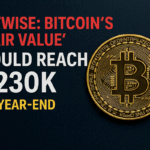📰 Texas Leads the Way: Strategic Bitcoin Reserve Bill Marks a Turning Point
— State-Level BTC Adoption May Reshape the Market Landscape —
The regulatory landscape for Bitcoin (BTC) in the United States is undergoing a quiet revolution—and Texas is now at the forefront. The recent passage of the Strategic Bitcoin Reserve Bill (SB21) by the Texas Legislature marks a potentially historic shift: Bitcoin is now being officially recognized as a strategic asset for state-level fiscal stability and economic competitiveness.
✅ A Growing Trend: States Embracing Bitcoin
Texas is not alone. Over 20 U.S. states have introduced similar legislation, signaling a broader trend: state governments are beginning to treat Bitcoin as a reserve asset—akin to gold—amid growing concerns over inflation, geopolitical instability, and the long-term viability of the U.S. dollar as the global reserve currency.
Texas, in particular, is uniquely positioned. With abundant energy resources and a robust Bitcoin mining infrastructure, its move is as symbolic as it is strategic—and it may serve as a model for other states.
💰 A $500 Billion Allocation Potential
If enacted, SB21 would allow Texas to invest an initial amount in the tens of millions of dollars in BTC, with a potential allocation of over $500 billion in the long run. This would be the first time a state-level public institution officially allocates part of its treasury to Bitcoin.
This shift could also legitimize BTC in the eyes of institutional players. Government participation provides regulatory validation, encouraging pensions, asset managers, and hedge funds to increase exposure.
📈 Market Impact: Three Strategic Takeaways
As a professional trader, here are three major implications of this development:
🔹 1. Medium- to Long-Term Price Floor Strengthens
With state governments potentially accumulating BTC, the market could experience stronger support during pullbacks, reducing downside volatility.
🔹 2. From Institutional to Public Sector Adoption
Until now, the narrative has been driven by firms like MicroStrategy and BlackRock. Now, governmental entities may become long-term holders, creating a structurally new class of buyers.
🔹 3. Decentralization Meets Institutionalization
While Bitcoin’s value lies in its decentralized nature, state-level adoption provides legal clarity, potentially catalyzing more capital inflows without compromising the core ethos.
🧭 Key Developments to Watch
- ✅ Texas Governor’s decision to sign SB21 and timeline for implementation
- ✅ Progress of similar bills in Florida, Wyoming, Arizona
- ✅ Crypto policy stances in the 2025 U.S. presidential election
- ✅ Correlation between BTC and U.S. 10-year yields / DXY (dollar index)
📌 2025: A Crucial Year for Bitcoin
2025 presents a rare convergence of supply-side restriction and demand-side expansion.
🔻 Supply-Side: The 2024 Halving
- Mining rewards cut from 6.25 to 3.125 BTC
- Historical precedent: Bitcoin typically hits new all-time highs the year after a halving
🔺 Demand-Side: Institutional + Public Sector Inflow
- Continued ETF inflows from BlackRock, Fidelity, etc.
- Public institutions (like U.S. states) beginning to accumulate
- Global interest rate softening → risk assets in favor
- Rising adoption in Asia (Hong Kong, Singapore, Japan)
📊 BTC Price Forecast Models for 2025
| Model | Assumption | Projected BTC Price |
|---|---|---|
| Stock-to-Flow (S2F) | Scarcity premium post-halving | $180,000–$250,000 |
| ETF + Public Sector Demand | Structural buying | $200,000–$280,000 |
| Network Growth | Wallet/user growth | $160,000–$220,000 |
✅ Final Trader Forecast (Median): $235,000
🎯 Range: $210,000 – $260,000
(Current price: $106,600)
⚠ Key Risks to Watch
- Delay or disappointment in U.S. interest rate cuts (USD strength)
- Heavy ETF redemptions or loss of investor momentum
- Large-scale hacks or DeFi exploits (e.g., the Cetus Protocol incident)
- Regulatory clampdowns or KYC tightening during election season
📝 Conclusion: Bitcoin Enters Its “Strategic Asset” Era
Texas’ Bitcoin reserve legislation is not just a policy move—it signals the arrival of a new class of buyers: governments. This could alter the nature of volatility itself, turning BTC into a more stable, long-term strategic asset rather than a speculative one.
The 2021 high of $69,000 now looks like a checkpoint—not a ceiling. With both supply compression and institutional/state-level demand converging, $200,000+ is no longer a moonshot—it’s a rational projection.
Now is not the time to “buy the news.” Now is the time to restructure portfolios with BTC as a core long-term asset—before the next wave of public adoption pushes it beyond reach.



![🚨 [Breaking News] Bitcoin Breaks Above $110,000! sdcdcd](https://cryptogoldexpert.com/wp-content/uploads/2025/06/sdcdcd-150x150.jpg)


